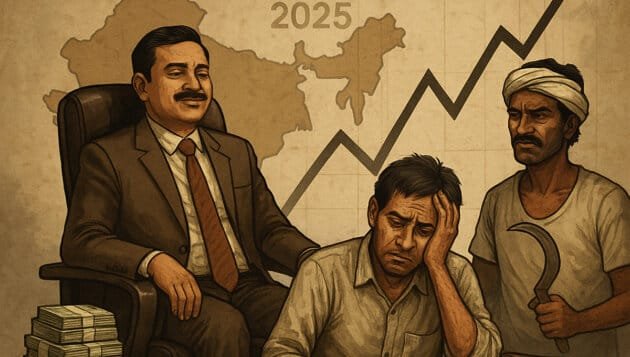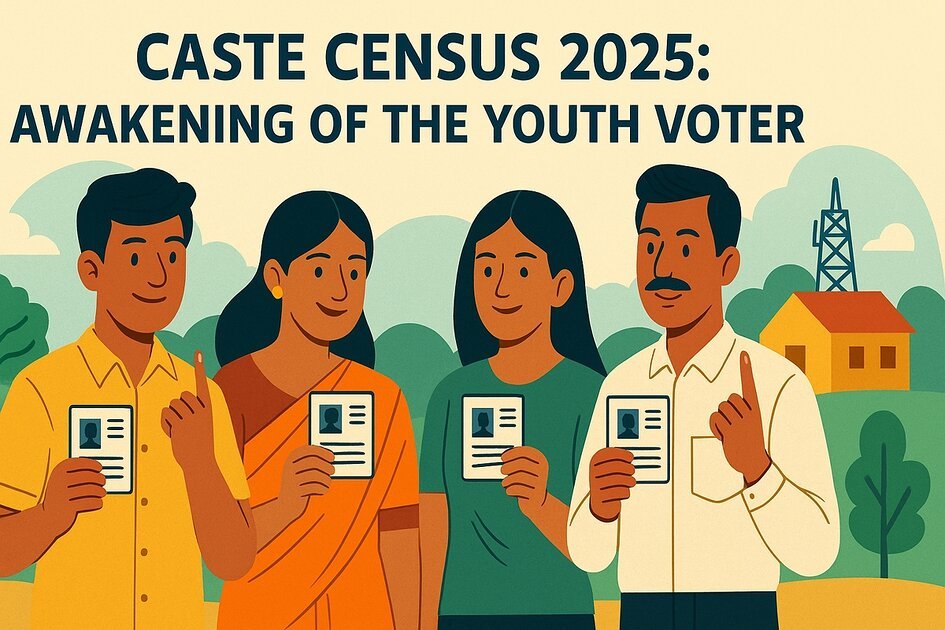Income Inequality in India and the Erosion of Humanity
Income Inequality in India is emerging as one of the most critical issues facing the country today. India, the world’s most populous democracy, stands at a crossroads. While GDP figures rise and urban skylines reach new heights, an unseen crisis is unfolding across the country — one of deepening income inequality.
In this emerging divide, a small elite earns in lakhs each month, while millions survive on a few thousand rupees. The consequences go beyond economics: dignity is eroded, resentment festers, and the idea of equality enshrined in the Constitution begins to decay. If not addressed, this inequality could become the greatest humanitarian failure of modern India.
Table of Contents
Income Inequality in India: What the Data Says About the Economic Divide
Explore World Inequality Database (DoFollow)
Read the Oxfam India Inequality Report 2023 (DoFollow)
Income Inequility in India Continues to widen at a concerning pace. This imbalance manifests sharply in employment sectors:
Comparative Earnings Snapshot:
- Permanent Government Employee: ₹60,000–₹1,20,000+ per month, plus benefits.
- Contractual Government Worker: ₹8,000–₹15,000 per month, with no benefits.
- Rural Farmer (Annual): ₹50,000–₹70,000 (~₹4,000–₹6,000/month).
- Private Sector CEO: ₹1 crore+ per year — often 800+ times a farmer’s income.
Wider Context:
- Urban income disparity is growing twice as fast as rural gaps.
- Students from low-income families cannot access quality education, despite equal potential.
- Health, infrastructure, and digital access remain skewed toward the affluent.
Income Inequality in India’s Public Sector: Contractual vs. Permanent Workers
The Case of Shiksha Mitras in Uttar Pradesh
Shiksha Mitras were introduced in Uttar Pradesh in 2001 as para-teachers to support the expanding needs of basic education. Once appointed on a modest honorarium, they now represent over 1.5 lakh education workers who face chronic insecurity and disrespect despite two decades of service.
Challenges Faced by Shiksha Mitras:
- Low and Stagnant Honorarium: Despite court directives and political promises, most Shiksha Mitras earn between ₹10,000–₹15,000/month, far below that of regular teachers.
- No Career Progression: There is no clear promotional path or transition scheme to permanent teacher status, despite years of experience and similar job duties.
- Legal and Policy Limbo: Their service conditions have repeatedly faced legal uncertainty, with court rulings challenging their appointment methods and pay parity claims.
- Lack of Recognition: Despite performing teaching, administrative, and examination duties, they are excluded from decision-making roles and training programs.
- Psychological Toll: Many face humiliation, financial stress, and feelings of betrayal by the system they’ve served loyally for years.
Proposed Solutions:
- Honorarium Increase: Set a minimum ₹30,000 monthly honorarium indexed to inflation and linked with performance.
- Transparent Absorption Framework: Develop a state-level roadmap for permanent absorption of long-serving Shiksha Mitras through bridge courses and qualification assessments.
- Legal Clarity: Enact clear legislation affirming their role and service status to end decades of litigation.
- Welfare Inclusion: Provide insurance, pension, leave, and housing benefits akin to regular teachers.
By ensuring respect, security, and equity for Shiksha Mitras, the government can reinforce its commitment to inclusive and just public education.
Government services are increasingly run by two classes: permanent staff and contractual workers. Despite similar workloads, their compensation is worlds apart.
The Case of Anudeshaks in Basic Education
Anudeshaks (Instructors) appointed under the Basic Shiksha Vibhag (Basic Education Department) in Uttar Pradesh represent a significant section of the contractual workforce in education. Appointed since 2013 to support upper primary schools, there are nearly 27,000 Anudeshaks deployed across the state.
Key Challenges Faced by Anudeshaks:
- Meager Fixed Honorarium: Anudeshaks receive a fixed monthly honorarium of ₹9,000, which has remained unchanged for over a decade. There are no dearness allowances, annual increments, or benefits.
- No Job Security: Despite over 10 years of continuous service in some cases, there is no pathway to permanency or inclusion in the state education cadre.
- No Social Security Benefits: They are not entitled to provident fund (PF), health insurance, or pension, unlike their regular counterparts.
- Equal Workload: Anudeshaks teach the same subjects, follow the same curriculum, and are assigned examination duties like permanent teachers, yet earn one-eighth the salary.
- Denied Respect: Often seen as temporary helpers, they are excluded from school decision-making processes and professional development workshops.
- Workplace Discrimination: Many regular teachers and headmasters assign Anudeshaks disproportionately more duties, using them as administrative assistants or utility staff. Despite being well-educated, they are treated with disregard, often humiliated, and made to feel inferior. Their presence is tolerated, not respected.
- Unjust Hierarchy: Although they contribute equally, Anudeshaks are systematically kept away from school-level decision forums and are denied recognition in student achievement or institutional success.
- Erosion of motivation and morale.
- High attrition due to financial instability.
- Families of Anudeshaks face poor access to healthcare, education, and nutrition.
Proposed Solutions:
- Immediate Wage Revision: Increase honorarium to at least ₹40,000/month indexed to inflation, reflecting not only the cost of living but also the skill level, workload parity, and inflation over the past decade. This would align instructors’ earnings closer to their permanent counterparts and help retain talent in the education system.
- Career Pathway: Create a bridge program allowing Anudeshaks to qualify for permanent teaching posts via internal exams or service-based absorption.
- Social Security: Extend ESIC, PF, maternity, and health insurance benefits.
- Equal Opportunity: Include them in training programs, staff meetings, and school governance.
- Regularization Policy: Frame a transparent policy to regularize those who have completed more than 10 years of continuous service.
Examples from Other States:
- In Himachal Pradesh and Rajasthan, contract instructors with 10+ years of service have been gradually absorbed into the education department.
- Delhi provides contractual teachers benefits like maternity leave and bonus increments.
By addressing the plight of Anudeshaks, India can set a precedent for fair employment and uphold the dignity of those who sustain the nation’s education system.
Income Inequality in India’s Agriculture: The Forgotten Farmer
Agriculture employs over 50% of India’s labor force, yet contributes only 18% to GDP. Farmers remain trapped in a cycle of low returns, debt, and despair.
Hard Truths:
- More than 70% of farmers are small/marginal, earning ₹6,000/month.
- Over 10,000 farmers die by suicide annually (NCRB). See NCRB data (DoFollow)
- MSP often doesn’t match real costs, and subsidies favor large landowners.
Real Example:
In Maharashtra, a farmer ended his life over a ₹25,000 debt. At the same time, corporate houses received tax waivers worth thousands of crores.
Contrast: A clerk in a public office earns more in a single month than many farmers earn all year.
What Happens If This Continues?
Income Inequality in India is more than an economic indicator—it’s a humanitarian emergency.
The Human Cost of Rising Inequality:
1. Loss of Human Dignity
When individuals receive wages far below the cost of living, they begin to lose faith in the system and in their own self-worth. The disparity creates a psychological divide, where the underpaid see themselves as lesser citizens. Over time, this fuels silent depression, helplessness, and widespread emotional exhaustion. A society that cannot protect the dignity of its workers eventually breeds a culture of despair.
2. Rise in Class Conflict
The visible gap between affluent government officials and struggling workers ignites class resentment. When hardworking individuals witness disproportionate compensation for equal work, frustration transforms into protest. This polarization can manifest in worker strikes, social media outrage, or even political extremism, as people lose hope in mainstream solutions.
3. Collapse of Welfare Systems
Welfare relies on mutual trust — between citizens and the state. If the underprivileged believe that policies cater only to the powerful, they may disengage entirely from civic responsibilities like voting, tax compliance, or legal redress. This disengagement erodes the very foundations of public systems, making them ineffective or corrupt.
4. Rural Exodus
Income inequality is especially stark in India’s rural belt. As agriculture becomes financially unsustainable, rural youth are forced to migrate to cities in search of informal or low-paying jobs. This leads to overcrowded urban settlements, increased unemployment, and declining food security. Entire villages are left aging and hollow, weakening the rural economy.
5. Democratic Decay
Democracy thrives on equal participation and representation. But when the same system continuously undervalues frontline workers—such as instructors, health workers, or small farmers—it undermines its legitimacy. Disenfranchised populations may disengage from democratic processes altogether, viewing them as rigged or elitist. In such a scenario, democracy becomes symbolic rather than functional.
The Case for an Equal Income Distribution Act
A Legislative Solution to Restore Balance:
India needs a dedicated law — the Equal Income Distribution Act — to ensure just, proportional, and transparent wage structures.
Key Components:
- Equal Pay for Equal Work: Mandatory wage parity for similar job roles.
- Fair Pay Ratio: Highest and lowest public sector salary capped at a 1:5 ratio.
- Farmer Income Guarantee: ₹2 lakh/year minimum assured income for registered farmers.
- Universal Work Benefits: Retirement, maternity, and health coverage for all public workers.
- Public Disclosure: Annual publication of wage distribution across all departments.
Such a law would not only promote fairness, but also build public trust, motivation, and economic inclusion.
Income Inequality and the 8th Pay Commission: A Looming Disaster for Equality?
Slated for implementation in 2026, the 8th Pay Commission could further widen inequality if introduced without structural reform. Government Pay Commission history and reforms (DoFollow)
Why It’s Concerning:
- Focuses solely on permanent employees.
- No provisions to uplift contractual or part-time workers.
- Risk of 20x–25x wage gaps within the same institutions.
The Fallout:
- Moral erosion within government departments.
- Deep frustration among lower-tier workers.
- Protests, strikes, or judicial interventions.
- Long-term inefficiency and disengagement from workers who feel exploited.
Unless accompanied by wage normalization and inclusive frameworks, the 8th Pay Commission may go down in history not as a step forward, but a step backward.
India’s Constitutional Values Are at Stake
Extreme income disparity does more than just divide society—it directly undermines the guiding principles of India’s Constitution. The constitutional framework of the Republic of India is built upon the ideals of justice, liberty, equality, and fraternity. When a nation allows gross economic inequality to fester—especially within its own public sector—it compromises its democratic promise.
Violated Principles:
- Article 14: Equality before Law
This article ensures that all individuals are treated equally before the law. However, when two government employees perform identical duties—like an Anudeshak and a permanent teacher—but receive drastically different wages, it becomes a clear violation of this constitutional safeguard. Income disparity in public employment sends a signal that law is not applied evenly. - Article 21: Right to Life and Personal Liberty
The right to life encompasses the right to live with dignity. Earning a wage that fails to meet basic living standards violates this right. If a contractual worker is unable to provide food, education, healthcare, or housing for their family, their dignity is compromised. The Constitution does not envision survival; it envisions a life of meaning. - Directive Principle 38: Promotion of Welfare of the People
This principle mandates that the state strive to minimize inequalities in income, status, and opportunities. Ignoring this clause results in policy failure and long-term socio-economic instability. By continuing with systems that reward privilege and ignore the working poor, the state fails in this fundamental duty.
Legal and Moral Consequences:
Such inequality not only erodes trust in the legal and democratic system but also invites judicial scrutiny and civic unrest. The Supreme Court of India has, in various judgments, reinforced the necessity of equal pay for equal work. Judicial Reference (DoFollow) Failure to act on this principle may also violate international conventions on labor rights to which India is a signatory.
A democratic state cannot afford selective justice. When the same public office produces dramatically different lives based on contract status or social background, democracy becomes symbolic rather than substantive.
Income Inequality in India: Global Perspectives and Lessons
| Country | Policy | Impact |
|---|---|---|
| Norway | Salary caps and social equity taxes | High equality and social satisfaction |
| Germany | Minimum wage, benefits, public healthcare | Balanced wealth, low unemployment |
| Canada | Subsidies for farmers and uniform public wages | Rural inclusion and high social trust |
What Should the Government Do Now?
To reverse the widening gap in income and restore fairness in the public and rural economic structure, a multi-pronged strategy is essential. The government must act decisively with both immediate interventions and long-term structural reforms.
Short-Term Actions:
- Raise Contractual Wages to a Minimum Living Standard: Contractual workers across departments must receive wages that reflect the cost of living. ₹15,000–₹20,000 per month should be the new baseline for state-employed contract staff, ensuring they can afford basic needs like housing, nutrition, healthcare, and education.
- Convert Long-Serving Contractual Roles into Permanent Posts: Many contractual workers have served for over 10–15 years, performing the same duties as permanent employees. Their conversion to permanent status would not only boost morale but also reduce legal inequalities. A transparent seniority-based regularization policy must be introduced.
- Mandate Wage Audits in Public Departments: Every government department should be required to conduct and publish annual wage audits comparing contract and permanent employees. These audits will bring transparency and help formulate targeted policies to reduce unjust gaps.
Long-Term Reforms:
- Pass Equal Income Distribution Act with Enforceable Provisions: This central law must mandate wage equality for equal work, set a cap on salary disparities within departments, and legally recognize the status of long-term contractual workers. It should also criminalize exploitative payment structures and provide a grievance redressal mechanism.
- Integrate Income Equality into Every Future Pay Commission: The Pay Commissions must evolve beyond merely adjusting salaries of already privileged sections. Future commissions should include provisions for uplifting the lowest-paid employees, correcting disparities, and ensuring inclusive wage growth across all categories of public workers.
- Establish a Humanitarian Commission to Monitor Compliance: An autonomous Humanitarian Equality Commission should be set up to oversee implementation of wage equity laws, investigate wage-related discrimination, and publish regular reports. It should also work with NITI Aayog and the Labour Ministry to ensure coordinated policy execution.
These measures, if implemented sincerely, can begin to reverse decades of neglect and bring justice to the backbone of India’s governance and food security systems — its farmers, instructors, health workers, and contractual staff.
Final Thoughts: India Must Choose Between Power and People
India’s story should not be one where wealth concentrates in the hands of the few while the many struggle to survive.
If inequality becomes institutionalized:
- Democracy becomes hollow.
- Civil unrest becomes inevitable.
- Human rights become negotiable.
But if we act now — with legislation, courage, and compassion — India can become a model for inclusive growth and justice.
To strengthen content relevance and keyword optimization, it’s important to note that Income Inequality in India is not confined to statistics — it’s reflected in every institution, every public school, and every neglected village. This article aims to expose the true impact of Income Inequality in India on human lives, especially those of Anudeshaks, Shiksha Mitras, farmers, and low-wage public workers. By building fair policies, India can address Income Inequality in India through legislation, economic restructuring, and long-term democratic responsibility.
This article discusses the urgent need to address income inequality in India — a crisis that affects millions of farmers, contractual workers, and underprivileged citizens. With widening disparities and institutional bias in pay scales, especially between Anudeshaks and permanent staff in the public sector, Income Inequality in India continues to challenge the nation’s commitment to justice and democracy. Tackling this crisis is not only a matter of economic fairness but of preserving humanity itself.
BRICS Expansion 2025: India’s Bold Role in a Changing Global Power Order
Powerful Surge: Indian Stock Market Today – Nifty & Sensex Climb 215+ Points Amid US Trade Uncertainty
Breakthrough Startup Surge in India: RBI’s Bold Cybersecurity Overhaul Defines 2025
Sardaar Ji 3 Controversy: Shocking Cross-Border Casting Ignites Bollywood Firestorm



